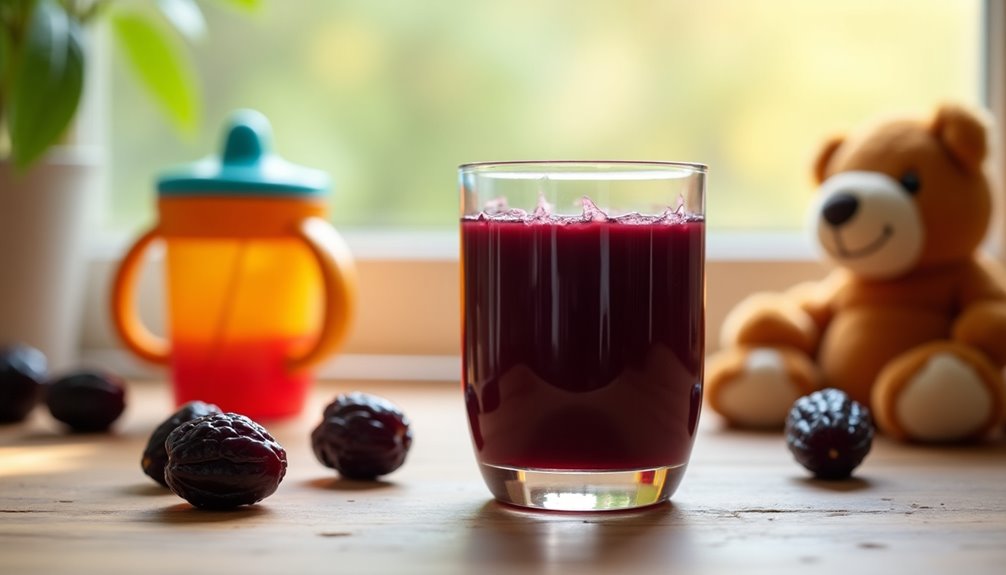For a 4-year-old, you can give up to 4 ounces of prune juice per day, but it's best to start with just 1 ounce to see how their stomach reacts. If your child tolerates it well, you can gradually increase the amount. Diluting the juice with an equal part of water can help reduce any irritation. Don't forget to keep them hydrated with other fluids too, and you'll find even more helpful tips on this topic.
Key Takeaways
- The safe dosage of prune juice for a 4-year-old is up to 4 ounces (118 ml) per day.
- Start with 1 ounce of prune juice to monitor the child's reaction before increasing the amount.
- Dilute prune juice with water in a 1:1 ratio to reduce stomach irritation.
- Offer diluted prune juice once or twice daily, preferably after meals for better effectiveness.
- Always consult a pediatrician before introducing prune juice and ensure a balanced diet with fiber-rich foods.

When you're looking to help your 4-year-old with constipation, prune juice can be a gentle solution. This natural remedy has been a go-to for many parents, thanks to its effectiveness and safety for young children. However, knowing how much prune juice to give your child is crucial. For a 4-year-old, you can safely offer up to 4 ounces (118 ml) of prune juice per day. This amount can help relieve constipation without causing any adverse effects.
It's wise to start with smaller quantities. You might begin with just 1 ounce and watch for how your child responds. Every child is different, and monitoring their reaction is key. If they handle that well, you can gradually increase the amount. Just be sure not to jump straight to the full 4 ounces right away; that could lead to stomach discomfort or cramping.
Prune juice is rich in fiber and sorbitol, a natural sugar that has a laxative effect. However, it can sometimes irritate a child's stomach. To reduce the risk of this, you can dilute the prune juice with water. Mixing one part prune juice with one part water can make it easier for your child to drink and can help prevent any potential tummy troubles. Offering this diluted juice once or twice daily, especially after meals, can be particularly effective. The timing is important; having the juice post-meal can enhance its efficacy in promoting bowel movements.
It's also essential to remember that prune juice shouldn't replace other fluids. While it can be a helpful addition to your child's diet, ensure that they're also drinking enough water throughout the day. Staying hydrated is crucial for preventing constipation. If your child is still breastfeeding, breast milk can provide hydration and nutritional support. However, as they grow, water should become a bigger part of their fluid intake.
Before introducing prune juice or making any significant changes to your child's diet, it's always best to consult a pediatrician. They'll help ensure that prune juice is appropriate for your child's individual health needs and will be able to provide guidance tailored to your situation.
As you navigate this journey, keep your child's meals balanced with fiber-rich foods like fruits, vegetables, and whole grains. These foods, combined with the occasional dose of prune juice, can create a powerful combination in preventing constipation.
Frequently Asked Questions
Is Prune Juice Good for a 4 Year Old?
Prune juice can be a good option for your 4-year-old, especially if they're dealing with constipation.
Its high sorbitol content acts as a natural laxative, helping soften stool and promote regular bowel movements.
Just make sure to introduce it gradually and keep an eye on how your child reacts. If they seem uncomfortable, you might need to adjust the amount.
Always consult your pediatrician before adding new foods to your child's diet.
What Can a 4 Year Old Take for Constipation?
Imagine your little one struggling in discomfort, eyes wide with frustration.
For constipation relief, you can offer plenty of fluids, fiber-rich fruits, and veggies to ease their tummy troubles. Prune juice can be a gentle ally—start with small amounts to see how their body reacts.
Don't forget to encourage regular bathroom breaks and keep water handy.
If constipation persists, it's wise to consult a pediatrician for tailored advice.
How Much Prune Juice Does a Toddler Need to Poop?
When your toddler needs help pooping, prune juice can be a useful option. You should start with about 2 to 4 ounces, diluted with water if necessary, to avoid any stomach irritation. You can gradually increase the amount if needed, but it’s essential to monitor how your child responds. Additionally, it’s wise to consult your pediatrician for any concerns about constipation or dietary changes. They can provide guidance on prune juice serving sizes for toddlers to ensure your little one gets the relief they need without any adverse effects.
Monitor how they respond; if it works, you can stick to that amount daily. Remember, combining prune juice with a fiber-rich diet will help promote regular bowel movements.
If constipation continues, don't hesitate to consult your pediatrician for advice.
How Much Miralax Can You Give a 4 Year Old?
When you're facing the challenge of constipation with your little one, Miralax can be a helpful ally.
For a 4-year-old, you typically start with ¼ to ½ capful mixed in 4-8 ounces of water or juice daily.
Keep an eye on how your child responds; you can increase it up to 1 capful if necessary.
Don't forget to check in with your pediatrician to tailor the dosage to your child's needs.
Conclusion
When it comes to giving prune juice to your 4-year-old, moderation is key. Just a couple of ounces can help with constipation, but too much can cause tummy troubles. Did you know that about 15% of young children experience constipation? By offering a small serving, you can support your child's digestive health without overwhelming their system. Remember, it's always best to consult your pediatrician to find the right balance for your little one.
Cindy thoroughly researches juicing trends, techniques, and recipes to provide readers with practical advice and inspiration. Her writing style is accessible, engaging, and designed to make complex concepts easy to understand. Cindy’s dedication to promoting the advantages of juicing shines through her work, empowering readers to make positive changes in their lives through the simple act of juicing.











